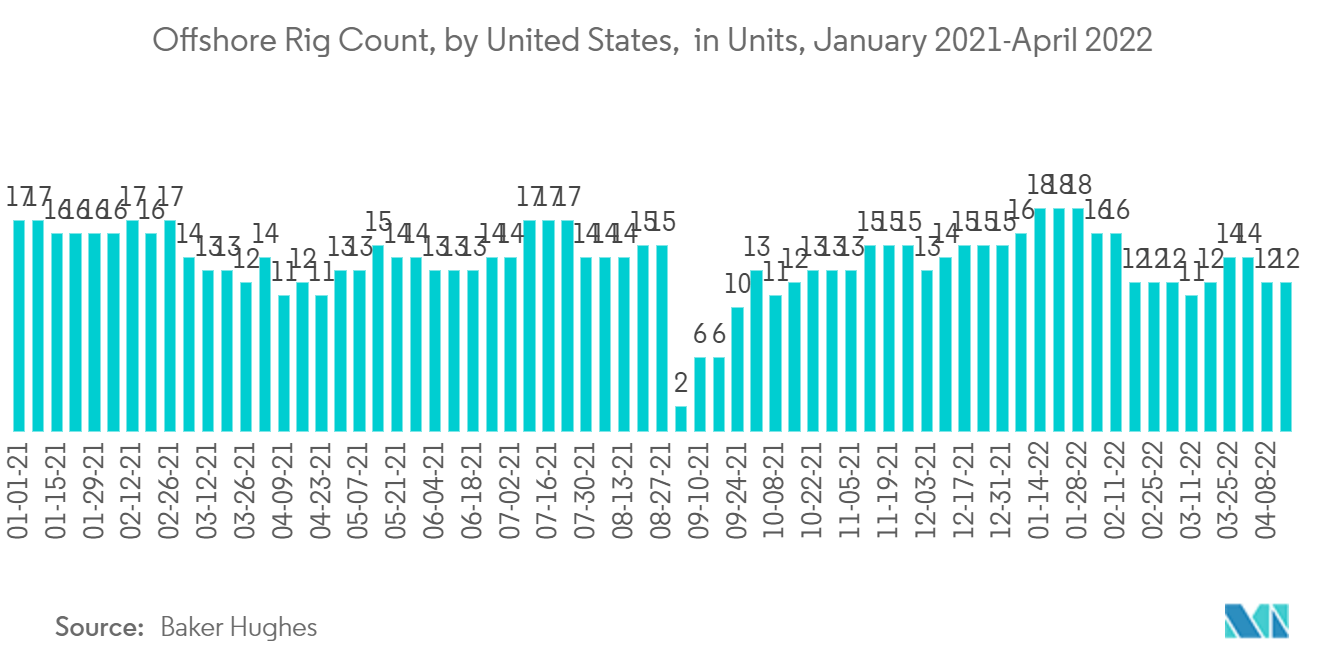Market Trends of North America ROV Industry
This section covers the major market trends shaping the North America ROV Market according to our research experts:
Oil & Gas Application to Dominate the Market
- Exploring, drilling, and developing these oil and gas fields from underwater locations is crucial to meet the ever-growing demand for these resources. Remotely Operated Vehicles (ROVs) are helpful in the oil and gas industry. They are robotic machines that can travel underwater to help with various subsea exploration and development activities.
- ROVs have become almost indispensable in the oil and gas industry. With a rise in the installation of underwater infrastructure for oil and gas field development, ROVs have become integral to operations.
- North America's oil production grew from 14,345 thousandbarrels per day in 2011 to 23,942 thousand barrels per day in 2021. The increasing oil production is expected to drive the North America ROV market during the forecast period.
- Further, with the increasing production of hydrocarbons delivered through subsea wells, the demand for introducing new technologies that can ensure the safe development and intervention of these wells, located under thousands of meters of water, is increasing. In addition, rising deepwater offshore development activities and improved viability of offshore oil and gas projects in countries such as the United States are expected to increase the number of subsea wells in the coming years. This increase may drive the demand for North America ROV systems in the oil and gas application during the forecast period.
- The ROV market is also likely to grow because of offshore decommissioning activities worldwide. After 1947, only in the Gulf of Mexico (GOM), over 4,750 structures were removed from the federal waters. Additionally, there were around 2,189 existing platforms in the GOM's OCS region, of which approximately 30% of platforms were non-producing or otherwise considered 'idle-iron' and had to be decommissioned.
- In March 2021, Oceaneering International, Inc. announces that Subsea Robotics (SSR) and Offshore Projects Group (OPG) awarded an integrated rig services contract for covering the Khaleesi/Mormont and Samurai fields in the United States Gulf of Mexico. The scope of work includes providing remotely operated vehicles (ROVs) with collocated ROV tooling and technicians, remote positioning and metrology survey resources, installation and workover control system (IWOCS) equipment, and technicians.
- The Canadian offshore oil and gas sector is relatively younger when compared to the United States and Mexican counterparts. Due to this, demand for ROVs is expected to be low in the Canadian offshore oil and gas sector. However, as most of Canada's offshore reserves are situated in higher latitudes, these places are prone to ice cover and floating ice blocks and sheets, which makes diving a dangerous job.
- Therefore, based on the factors mentioned above, the oil and gas application segment is expected to dominate the North America ROV market during the forecast period.

The United States to Dominate the Market
- The United States has invested heavily in expanding its oil and gas production capacity, and the Gulf of Mexico has become a global hotspot for ROV demand. As of 2021, the Gulf of Mexico region is responsible for 97% and 15% of the United States' offshore and total hydrocarbon production, respectively. The region has one of the highest global densities of offshore rig deployment and consists of other oil and gas infrastructures such as production and drilling platforms, marine vessels and pipeline networks.
- ROVs are incredibly complex and serve a wide variety of sectors such as search and rescue, military, aquaculture, recreation, discovery, oil, and gas industry, offshore energy, submerged infrastructure, shipping, and more. Some of the major factors driving the market studied include rising offshore oil and gas production activities, growing offshore wind power industry, and increasing offshore oil and gas decommissioning activities.
- As ROV technology has become increasingly affordable oil and gas producers in the United States have been inclined toward investing in ROV services for obtaining data and carrying out routine maintenance work on subsea assets and surfaces. Despite the higher upfront cost when compared to diving crews, ROVs need lesser amount of time to complete the same amount of work, which reduces overall project OPEX.
- Due to this, multiple contracts are routinely dealt out by major oil and gas companies for ROV services in the Gulf of Mexico. In January 2021, Oceaneering announced that its subsea segment had won multiple contracts totalling USD 225 million. The contracts were issued by iinternational oil and gas operators and marine construction companies, and the contracted services include remotely operated vehicle (ROV) services delivered from floating drilling rigs and multi-service, subsea intervention, and construction vessels, ROV tooling, survey, positioning, and autonomous underwater vehicle services.
- According to the Bureau of Safety and Environmental Enforcement (BSEE) and Bureau of Ocean Energy Management (BOEM), the GOM Shallow Water Province, generally of water depth less than 200 meters, has been a prolific area accounting for 33% of the Gulf's gas production and over 10% of its oil production. However, in the past 10 years, the number of wells drilled in the shallow water province decreased by 89%, and approximately 100 platforms a year are being removed with no new platforms being installed. Therefore, if this trend continues, the lack of development will potentially strand 179 million barrels of oil and 4,567 billion cubic feet of natural gas. According to BSEE and BOEM, they have an estimated worth of USD 20 billion.
- Hence, due to such factors, the United States is likely to dominate the North America ROV market during the forecast period.


